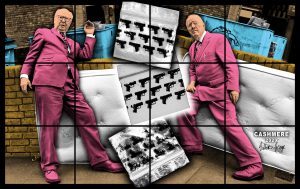 Art14, Olympia Grand, London Photo Mark Westall
Art14, Olympia Grand, London Photo Mark Westall
Art fairs are complex beasts because they admit of so many interpretations that most people cannot hold simultaneously. They are cultural farmers markets, celebrity hotspots, arenas of business, a capricious day out or a site of curious innovation. Generally people will go to the fair for one of these reasons and either complain about or block from sight all the others. But if you can find in your cynical heart a space to view art fairs as all these things simultaneously, then their true value shines through.
In recent years, art fairs have become bigger and more numerous all over the world; in London alone, we have Frieze, Moniker, The Other Art Fair, Affordable Art Fair, Kinetica, London Art Fair, Original Print Fair and Art14, which opens today. Their popularity derives in no small part from economic woe. A lot of galleries are not making enough money to sustain commercial rents, so have been forced to vacate properties all over London, settling instead for a programme of popup exhibitions and a presence at international fairs. Even galleries in London’s traditional art-dealing districts – Mayfair and St James’ – are being priced out by fashion boutiques to such an alarming extent that Westminster council is considering proposals to establish a protected area for art galleries. It was revealed recently, for example, that Damien Hirst’s gallery, Other Criteria, pays £480,000 a year in rent for its rather pokey New Bond Street premises; he is in a minority who can afford that without sustaining serious losses.
This net result of this is more and more galleries are turning to the fairs as a relatively affordable way of doing business. Not only does it dispense with the need for a permeant commercial space, but it also has the advantage of a broad spectrum of voluntarily cornered clients who have come to do a lot of business in a very short amount of time. The trading floor atmosphere of the fair oils the wheels of business by making it seem so very urgent and yet the circus-like performance of it all lends it a certain glamour. But whilst it solves a number of business problems for galleries and clients, what does it have to offer the casual observer?
The key to enjoying an art fair as a mere observer is to see it, not as a soulless corporate dehumanisation of culture, but as a fleeting spectacle that offers a unique way of experiencing contemporary art. Aside from the voyeuristic, gossipy pleasure of celebrity spotting, poncing about in silly outfits and witnessing breathtakingly absurd sales pitches, which is all good fun, art fairs are really just big exhibitions. It is a group show wherein disparate galleries are forced to show side by side, making the move from one booth to another an experience of extraordinarily perverse curatorial curiosity, as if you had happened upon the warehouse of a collector with unfathomably diverse tastes. The sheer range of work on display ensures that sooner or later you’ll see something like and guarantees that you will discover a lot of things you never expected, thought about or heard of. As such, the art fair is a place of discovery, much like a jumble sale, which is a rewarding experience in itself.
There is also an unusually democratic nature to the fair insofar as the structure of the booths has the effect of more or less homogenising galleries who normally make stylistic claims to an identity. But at the fair, all the booths are much the same, creating a space in which to view the art in its own terms, especially if you’re not there to buy then the identity of the gallery is irrelevant to you. This dimension of the fair as an exhibition is only bolstered by peripheral fancies of bars, drinks receptions, talks and performances, which all serve to add an element of fun as well as to break up the monumental task of seeing everything in the fair. The final thing about the art fair is that, since it is primarily a commercial enterprise, it is utterly fleeting in that once the arg has been bought there is no telling where it is going to end up or whether you’ll ever get the chance to see it again. It is worth going for this reason alone, if only to see what the wicked art market is trying to deprive you of.
Art fairs are the pinnacle of artworld spectacle, where commerce, criticism, celebrity, socialising, scholarship, networking and negotiating convene in a manner not dissimilar to the travelling fun fair or circus. In this sense, art fairs should be fun, and unless you stand to make money from them (which few people do) then they should be regarded as harmless fun for all the family. Visiting an art fair as a mere observer gives you the gleeful abandon and unabashed thrill of a child on a day trip to the circus, enjoying the spectacle and the treats, while the stuffy, joyless grownups do their mysterious and interminably dull business.









